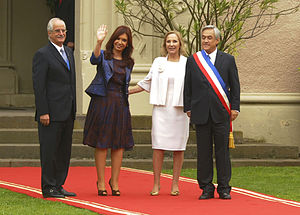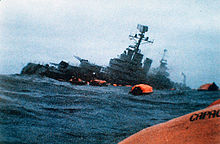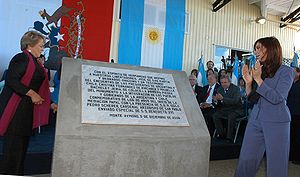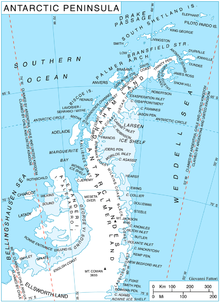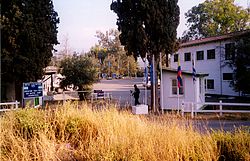- Argentina–Chile relations
-
Chile–Argentina relations 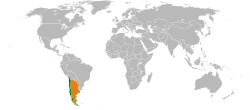

Chile
ArgentinaArgentina–Chile relations refers to interstate relations between the Republic of Chile and the Argentine Republic. Argentina and Chile share the world's third-longest international border, which is 5,300 km (3,300 mi) long and runs from north to the south along the Andes mountains. Although gaining their independency together, during much of the 19th and the 20th century, relations between the countries chilled due to disputes over Patagonia, though in recent years relations have improved dramatically. Despite increased trade between the two countries they have followed quite different economic policies; Chile has signed free trade agreements with countries such as China, the USA, Canada, South Korea and the EU and is an active member of the APEC, while Argentina belongs to the Mercosur regional free trade area. Both countries are members of the Union of South American Nations.
Contents
Historical relations (1550–1989)
Rule under Spain and Independence
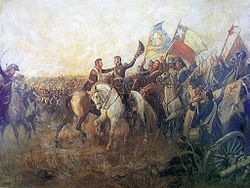 El abrazo de Maipú (English: The embrace of Maipú) between the independence heroes José de San Martín and Bernardo O'Higgins after the defeat of royalists in the Battle of Maipú
El abrazo de Maipú (English: The embrace of Maipú) between the independence heroes José de San Martín and Bernardo O'Higgins after the defeat of royalists in the Battle of Maipú
The relationship between the two countries can be traced back to an alliance during colonial times. Both colonies were offshoots of the Viceroyalty of Peru, with the Viceroyalty of the Río de la Plata (which Argentina was a part of) being broken off in 1776, and Chile not being broken off until independence. Argentina and Chile were however colonized in different processes, Chile was conquered as an southward extension of the conquest of Peru while Argentina was colonized both from Peru, Chile and from the Atlantic.
Argentina and Chile were close allies during the wars of independence from the Spanish Empire. Chile, like most of the revolting colonies, was defeated at a point by Spanish armies, while Argentina remained independent throughout its war of independence. After the Chilean defeat in the Disaster of Rancagua, the remnants of the Chilean Army led by Bernardo O'Higgins took refuge in Mendoza. Argentine General José de San Martín, by that time governor of the region, included the Chilean exiles in the Army of the Andes, and in 1817 led the crossing of the Andes, defeated the Spaniards, and confirmed the Chilean Independence. While he was in Santiago, Chile a cabildo abierto (open town hall meeting) offered San Martín the governorship of Chile, which he declined, in order to continue the liberating campaign in Peru.
Main article: First Chilean Navy SquadronIn 1817 Chile began the build up of its Navy in order to carry the war to the Viceroyalty of Perú. Chile and Argentina signed a treaty.[1] Meanwhile, an envoy from Chile was sent to London inviting Lord Cochrane. The naval fleet, after being built, launched a sea campaign to fight the Spanish fleet in the Pacific to liberate Peru. After a successful land and sea campaign, San Martín proclaimed the Independence of Peru in 1821.
War against the Peru–Bolivian Confederation
From 1836 to 1839 Chile and Argentine fought united against the confederation due the potential power of this aroused the opposition of Argentina and, above all, Chile, due not only to its great territorial expanse but also to the perceived threat that such a rich state signified for the area. Chile declared the war on 11 November 1836 and Argentina on 19 May 1837[2](p263ff).
In 1837 Felipe Braun, one of Santa Cruz's most capable generals and high decorated veteran of the war of independence, defeated an Argentine army sent to topple Santa Cruz. On 12 November 1838 Argentine representants signed an agreement with the Bolivian troops.[2](p271). On 20 January 1839 the Chilean troops obtained a decisive victory in the Battle of Yungay and the short-lived Peru-Bolivian Confederation now came to an end.
Chincha's war
During a series of coastal and naval battles between Spain and its former colonies of Peru and Chile from 1864 to 1866, that began with Spain's seizure of the guano-rich Chincha Islands, part of a series of attempts by Isabel II of Spain to reassert her country's lost influence in its former South American empire, an alliance was formed between Ecuador, Bolivia, Peru and Chile against Spain. In this way, all the ports of the Pacific coast of South America south of Colombia became closed and hostile to the Spanish fleet. But Argentina refused to join the alliance and maintained amicable relations with Spain[3] and delivered coal to the Spanish fleet.
War of the Pacific
Peru and Bolivia signed on 6 February 1873 in Lima the secret Treaty of alliance against Chile and on 24 September the Argentine president Domingo Faustino Sarmiento asked the Argentine Chamber of Deputies to join. The chamber approved with 48 to 18 votes the treaty and made available a credit of 6.000.000 pesos for military spending. But in 1874, after the delivery of the Chilean ironclad Almirante Cochrane and the ironclad Blanco Encalada, the Argentine Senate postponed the matter until the end of 1874 and Sarmiento could not sign the treaty.[4] During the war Argentina remain neutral and signed with Chile the Border Treaty of 1881.
Claims on Patagonia
See also: Boundary treaty of 1881 between Chile and Argentina and Treaty of Arbitration between Chile and Argentina of 1902The border disputes continued as Patagonia was still an unexplored area. The Border treaty of 1881 established the highest mountains that divides the drainage basins to the Pacific Ocean and the Atlantic as the border. This concept was easy to apply in northern regions but in Patagonia drainage basins crossed the Andes; this led to dispute what over the highest peaks would be the frontier (favouring Argentina) or the drainage basins (favouring Chile). Argentina argued that previous documents referring to the boundary always mentioned the Snowy Cordillera as the frontier and not the continental divide. The Argentine explorer Francisco Perito Moreno suggested that many Patagonian lakes draining to the Pacific were in fact part of the Atlantic basin but had been moraine-dammed during the quaternary glaciations changing their outlets to the west. In 1902, war was again avoided when British King Edward VII agreed to mediate between the two nations. He established the current border in the Patagonia region in part by dividing many disputed lakes into two equal parts, most of these lakes still have one name on each side of the frontier. A dispute that arose in the northern Puna de Atacama was resolved with the Puna de Atacama Lawsuit of 1899.
Baltimore Crisis
During the Baltimore Crisis, that brought Chile and the United States on the brink of war in 1891, at the end of the Chilean Civil War, the Argentine foreign minister Estanislao Zeballos offered to the US-minister in Buenos Aires the Argentine province of Salta as basis to attack Chile overland[5](p65) in return for the session of southern Chile to Argentina.[6] Later, Chile and the United States averted the war.
Pactos de Mayo
The Pactos de Mayo are four protocols signed in Santiago de Chile by Chile and Argentina on 28 May 1902 in order to extend their relations and resolve its territorial disputes. The disputes had led both countries to increase their military budgets and run an arms race in the 1890s. More significantly the two countries divided their influence in Latin America into two spheres: Argentina would not threaten Chiles Pacific Coast hegemony, and Santiago promised not to intrude beyond the Andes.[5]:page 71
Beagle conflict
Trouble once again began to brew in the 1960s, when Argentina began to claim that the Picton, Lennox and Nueva islands in the Beagle Channel were rightfully hers, although this was in direct contradiction of the 1881 treaty, as the Beagle Channel Arbitration, and the initial Beagle Channel cartography since 1881 stated.
Both countries submitted the controversy to binding arbitration by the international tribunal. The award (see Beagle Channel Arbitration between the Republic of Argentina and the Republic of Chile, Report and Decision of the Court of Arbitration) recognized 1977 all the islands to Chile, but Argentine unilaterally repudiated the sentence and planned a war of aggression against Chile.[7]
In 1978 Direct negotiations between Chile and Argentina in 1977-78 failed and relations became extremely tense. Chile and Argentina sent troops to the border in Patagonia and large areas were mined. Argentina started on 22 December the Operation Soberanía in order to invade the islands and continental Chile, but after few hours stopped the operation when the Pope John Paul II sent a personal message to both presidents urging a peaceful solution. Both countries agreed for the Pope to mediate the dispute through the offices of Cardinal Antonio Samoré his special envoy (See Papal mediation in the Beagle conflict).
On 9 January 1979 the Act of Montevideo was signed in Uruguay pledging both sides to a peaceful solution and a return to the military situation of early 1977. The conflict was still latent during the Falklands war and was resolved only after the fall of the Argentine military junta.
A number of prominent public officials in Chile still point to past Argentine treaty repudiations when referring to relations between the two neighbors.[8][9][10][11][12][13]
Falklands War
During the Falklands War in 1982, with the still pending Beagle conflict, Chile and Colombia became the only Latin American countries to abstain from voting in the TIAR (as did also USA and Trinidad Tobago).
The Argentine government planned to seize the disputed Beagle Channel islands after the occupation of the Falkland Islands. Basilio Lami Dozo former Chief of the Argentine Air Force during the Falklands war disclosed that Leopoldo Galtieri announced him that "[Chile] have to know what we are doing now, because they will be the next in turn.[14] Also Óscar Camilión, the last Argentine Foreign Minister before the war (March 29, 1981 to December 11, 1981) stated that "The military planning was, after the solution of the Falklands case, to invade the disputed islands in the Beagle. That was the determination of the Argentine Navy."[15] Such preparations were public. On June 2, 1982 the newspaper La Prensa published an article by Manfred Schönfeld explaining what would follow Argentina's expected victory in the Falkland Islands: "The war will not be finished for us, because after the defeat of our enemies in the Falklands, they must be blown away from South Georgia, the South Sandwich Islands, and all Argentine Austral archipelagos."[16]
This intention was probably known by the Chilean government[17] as the Chileans provided the United Kingdom with ‘limited, but significant information’ . The Chilean Connection is described in detail by Sir Lawrence Freedman in his book The Official History of the Falklands Campaign.
Post-Pinochet democratic governments have given greater support to the Argentine claim on the Falkland Islands.[18][19][20][21]
Peace and Friendship Treaty
The Peace and Amity Treaty of 1984 was an agreement signed in 1984 between Argentina and Chile establishing the friendship relation between the two countries. Particularly, the treaty also defines limitation of the Strait of Magellan and over the possession of the Picton, Lennox and Nueva islands and sea located south of Tierra del Fuego, granting the islands to Chile, navigation rights to both countries and the most part of the Exclusive Economic Zone eastwards of the Cape Horn-Meridian to Argentina. After that, other border disputes were resolved by peaceful means.
The 1984 treaty was succeeded by the Maipu Treaty of Integration and Cooperation (Tratado de Maipú de Integración y Cooperación) signed on October 30, 2009 [22]
Integration
In the 1990s relations improved dramatically. The dictator and last president of the Argentine Military Junta General Reynaldo Bignone called for democratic elections in 1983 and Augusto Pinochet of Chile in 1989. As a consequence militaristic tendencies faded in the Southern Cone. The Argentine presidents Carlos Menem and Fernando de la Rúa had particularly good relations with Chile.
Border issues
In bilateral manner, both countries settled all the remaining disputes except Laguna del Desierto, which was decided by International Arbitration in 1994. The decision favoured Argentine claims.
According to a 1998 negotiation held in Buenos Aires, a 50 km (31 mi) section of the boundary in the Southern Patagonian Ice Field is still pending of mapping and demarcation according to the limits already settled by the 1881 treaty. In 2006 president Néstor Kirchner invited Chile to define the border, but Michelle Bachelet's government left the invitation unanswered.[23] The same year, the Chilean government sent a note to Argentina complaining about Argentine tourism maps that showed a normal boundary in the Southern Patagonian Icefield with most of the area belonging to Argentina. (map of the area)[dead link]
Officially Chile supports the Argentine claim on the Falkland Islands.[19][24]
Geopolitics over Antarctica and the control of the passages between the south Atlantic and the south Pacific have led to the founding of cities and towns such as Ushuaia and Puerto Williams both claiming to be the southernmost cities in world. Actually in Antarctica both countries, along with the United Kingdom, have research bases. The three nations claim the totality of Antarctic Peninsula.
Economy and energy
Trade between the two countries is made mostly over the mountain passes (see list) that have enough infrastructure for large scale trade. The trade balance shows a lot of asymmetry as of 2005 Chile is the 3rd export trading partner for Argentina, behind Brazil and the United States.[25] Some well known import products from Argentina in Chile include cereals and meat that once caused the Meat riots in Chile. More recently large amounts of Chilean capital have been invested in Argentina, especially in the retail market.
In 1996, Chile became an associated member of Mercosur, a regional trade agreement that Argentina and Brazil created in the 1990s. This associated membership does not mean full membership.
In 1997, Argentina and Chile signed a Mining Integration Agreement.[26] In 2009 they gave the go-ahead for the $3-billion Pascua Lama project[27] to mine an ore body on the border of the two countries.
Gas
Argentine president Carlos Menem signed a natural gas exportation treaty with Chilean president Eduardo Frei Ruiz-Tagle in 1996. In 2005, President Néstor Kirchner suspended the treaty due to a supply shortage experienced by Argentina. The situation in Argentina was partly resolved when Argentina increased its own imports from Bolivia, a country with no diplomatic relations with Chile since 1978. In the import contract signed with Bolivia it was specified that not even a drop of Bolivian gas could be sold to Chile from Argentina.
Sports
In 2003, Argentine AFA's president suggested that both countries launch a joint bid for the 2014 FIFA World Cup but was abandoned in favour of a CONMEBOL unified posture to allow the tournament be hosted in Brazil.
In 2009, both countries organized the Dakar Rally, the first time the competition goes out of Africa. The event repeated in 2010 [28] and would be again in 2011 [29]
Technology
Argentina announced on 28 August 2009[30] the election of the Japanese/Brazilian ISDB-T digital television standard with Chile following the same direction on 14 September.[31]
Military integration
Since 1990s, both militaries began a close defense cooperation and friendship policy. On September 1991 they signed together with Brazil, the Mendoza Declaration, which commits signatories not to use, develop, produce, acquire, stock, or transfer —directly or indirectly— chemical or biological weapons.
Joint exercises were established on an annual basis in the three armed forces alternately in Argentina and Chile territory. An example of such manoeuvres is the Patrulla Antártica Naval Combinada (English: Joint Antarctic Naval Patrol) performed by both Navies to guarantee safety to all touristic and scientific ships that are in transit within the Antarctic Peninsula.
Both nations are highly involved in UN peacekeeping missions. UNFICYP in Cyprus was a precedent where Chilean troops are embedded in the Argentine contingent.[32] They played a key role together at MINUSTAH in Haiti(Video Haiti) and in 2005 they began the formation of a joint force for future United Nations mandates.[33] Named Cruz del Sur (English: Crux), the new force began assembly in 2008 with headquarters alternately on each country every year.[34]
In 2005, while the Argentine Navy school ship ARA Libertad was under overhaul, Argentine cadets were invited to complete their graduation on the Chilean Navy school ship Esmeralda[35] and in another gesture of confidence, on 24 June 2007, a Gendarmeria Nacional Argentina (Border Guard) patrol was given permission to enter Chile to rescue tourists after their bus became trapped in snow.[36]
Present
On 30 October 2009 presidents Michelle Bachelet and Cristina Fernández de Kirchner signed the Maipu Treaty of Integration and Cooperation ( Spanish: Tratado de Maipú de Integración y Cooperación ) [7] which establish the basis for the future relationship between the two countries.
On 13 March 2010 after the Chilean earthquake the benefit concert Argentina Abraza Chile (English: Argentina Hugs Chile) is done at Buenos Aires and the Argentine Air Force Mobile Field Hospital is deployed to Curicó.
On 8 April 2010 the new Chilean president Sebastián Piñera on his first trip abroad visited Buenos Aires where he thanked president Cristina Fernández for the help received due the earthquake occurred last February. He also stated his commitment to a deeper integration [37]
On June 2010 (as in 2009[38] and years before [39][40][41][42]) Chile supported again the Argentina position on the United Nations Special Committee on Decolonization calling for direct negotiations between Argentina and the United Kingdom about the Falklands Islands dispute.[43]
In September 2010 the CONARE (the Argentine National Refugee Commission, dependent of the Interior Ministry[44]) gave asylum to Chilean citizen Galvarino Apablaza, who lives in Argentina married with journalist Paula Chain and have three Argentine-born childs. Chain works for the Argentine Government press office since 2009.[45] Apablaza is accused of being involved with the murder of Chilean Senator Jaime Guzmán in 1991, during the government of Patricio Aylwin, as well as the kidnapping of the son of one of the owners of El Mercurio newspaper. The asylum is rejected by all Chilean political forces,[46] and by the Argentine political opposition forces.[47] Some Argentine media and journalists[48] pointed out that the Argentine government ignored a ruling of the Argentine Supreme Court of Justice allowing the extradition of Apablaza.[46] The Chilean's lawyer of the State, Gustavo Gené, pointed out that there was no questioning of the Chilean legal system by the Argentine Commission, and that the reasons for granting political asylum were only "humanitarian".[49]
On October 28, 2010 president Sebastian Piñera traveled to Buenos Aires to give their condolences for Néstor Kirchner death [50]
On December 2010, the joint peacekeeping force Cruz del Sur will be presented to the UN.[51] However, the demarcation of the limit in Campo de Hielo Sur (which historically Chileans had considered as a closed matter) remains an unresolved issue of controversy between these two nations.
Gallery
-
subsequent proclamation of Chilean independence with the presence of the Flag of Argentina
See also
References
- (Spanish) Historia de las Relaciones Exteriores Argentinas by Carlos Escudé and Andrés Cisneros
- (Spanish) Combined Military Force Cruz del Sur - official press release
- ^ The annual register, or, A view of the history, politics, and literature for 1819, Volume 61, John Davis Batchelder Collection (Library of Congress) url, page 138
- ^ a b José María Rosa, "Historia argentina: Unitarios y federales (1826–1841)", http://books.google.de/books?id=i39pAAAAIAAJ
- ^ Spain and the American Civil War: relations at mid-century, 1855–1868, page 99, http://books.google.de/books?id=rWT-LdWMdI0C
- ^ Las relaciones con los demás países americanos durante las presidencias de Mitre y Sarmiento
- ^ a b William F. Sater, Chile and the United States, Empires in Conflict, University of Georgia Press, 1990, ISBN 0-8203-1249-5
- ^ Arthur Preston Whitaker, The United States and the southern cone: Argentina, Chile, and Uruguay, Harvard University Press, 1976, page 34
- ^ Clarín de Buenos Aires 20 December 1998
- ^ See notes of the Chilean Foreign Minister Jose Miguel Insulza, in La Tercera de Santiago de Chile 13 July 1998 "Enfatizó que, si bien la situación es diferente, lo que hoy está ocurriendo con el Tratado de Campo de Hielo Sur hace recordar a la opinión pública lo sucedido en 1977, durante la disputa territorial por el Canal de Beagle"
- ^ See notes of Senator (not elected but named by the Armed Forces) Jorge Martínez Bush in La Tercera de Santiago de Chile 26 July 1998 "El legislador expuso que los chilenos mantienen "muy fresca" en la memoria la situación creada cuando Argentina declaró nulo el arbitraje sobre el canal del Beagle, en 1978"
- ^ See notes of the Chilean Foreign Minister Ignacio Walker "Y está en la retina de los chilenos el laudo de Su Majestad Británica, en el Beagle, que fue declarado insanablemente nulo por la Argentina. Esa impresión todavía está instalada en la sociedad chilena." Clarin de B.A., 22 July 2005
- ^ See also "Reciprocidad en las Relaciones Chile - Argentina" of Andrés Fabio Oelckers Sainz. "También en Chile, todavía genera un gran rechazo el hecho que Argentina declarase nulo el fallo arbitral británico y además en una primera instancia postergara la firma del laudo papal por el diferendo del Beagle"
- ^ See notes of Director académico de la Facultad Latinoamericana de Ciencias Sociales Flacso, Francisco Rojas, in Santiago de Chile, in "Desde la Argentina, cuesta entender el nivel de desconfianza que hoy existe en Chile a propósito de la decisión que tomó en 1978 de declarar nulo el laudo arbitral" La Nación de Buenos Aires 26 September 1997
- ^ See notes of Chilean Defense Minister Edmundo Pérez Yoma in "Centro Superior de Estudios de la Defensa Nacional del Reino de España" " ... Y que la Argentina estuvo a punto de llevar a cabo una invasión sobre territorio de Chile en 1978 ...", appeared in Argentine newspaperEl Cronista Comercial 5 May 1997. These notes were later relativized by the Chilean Government (See [1] [2])
- ^ Argentine newspaper Perfil Después de Malvinas, iban a atacar a Chile on 22. November 2009, retrieved 22. November 2009:
- Para colmo, Galtieri dijo en un discurso: "Que saquen el ejemplo de lo que estamos haciendo ahora porque después les toca a ellos".
- ^ Óscar Camilión, Memorias Políticas, Editorial Planeta, Buenos Aires, 1999, page 281:
- "Los planes militares eran, en la hipótesis de resolver el caso Malvinas, invadir las islas en disputa en el Beagle. Esa era la decisión de la Armada ..."
- ^ All articles of Manfred Schönfeld published by "La Prensa" from 10 January 1982 to 2 August 1982, are compiled in La Guerra Austral, Manfred Schönfeld, Desafío Editores S.A., 1982, ISBN 950-0205-00-9
- ^ Spanish newspaper El País on 11. April 1982 Chile teme que Argentina pueda repetir una acción de fuerza en el canal de Beagle retrieved on 11. September 2010
- ^ President Bachelet:We not only support our sister republic's claims to the Malvinas islands but every year we present its case to the United Nations' Special Committee on Decolonization
- ^ a b Chile supported the rights of Argentina in the dispute, believing that the only viable way forward was through bilateral negotiations between Argentina and the United Kingdom
- ^ Chilean Foreign Office: CHILE REAFIRMA SU POSICIÓN SOBRE ISLAS MALVINAS
- ^ Chilean Foreign Minister Soledad Alvear reaffirms support to Argentine claim
- ^ Tratado de Maipu de Integración y Cooperacion entre Argentina y Chile
- ^ Tras la fricción por los Hielos Continentales, la Argentina llama a Chile a demarcar los límites "lo antes posible"
- ^ [3] CHILE REAFIRMA SU POSICIÓN SOBRE ISLAS MALVINAS. La Cancillería reafirmó la política del Gobierno de Chile de respaldar los legítimos derechos de soberanía de la República Argentina en la disputa referida a la cuestión de las Islas Malvinas.
- ^ Argentina Exports - partners - Economy
- ^ Tratado Sobre Integración y Complementación Minera entre las repúblicas de Chile y Argentina
- ^ Argentina celebrates mining day, Pascua Lama go-ahead
- ^ [4]
- ^ [5]
- ^ "Argentina: Adopta nueva norma de TV Digital [Argentina: It adopts new norm of Digital TV]" (in Spanish language). 2009 CIO América Latina. http://www.cioal.com/analisis/negocios/argentina-adopta-nueva-norma-de-tv-digital673.html. Retrieved 29 August 2009.
- ^ [6] Gobierno de Chile adopta norma de Televisión Digital para el País
- ^ Argentine Army: UNFICYP
UN: Cyprus - UNFICYP - Facts and Figures
Chilean Army: Misión de la ONU en Chipre desde el año 2003
Brasilian Army: UNFICYP - ^ Avance para la fuerza combinada con Chile
- ^ Destinan $30 millones para operar con Chile
- ^ Cadetes argentinos navegarán en la fragata chilena Esmeralda
- ^ "Rescatan a 50 pasajeros que quedaron varados por la nieve en el norte chileno" Clarin newspaper: (Spanish)
- ^ Piñera: "Lo mejor de la relación entre la Argentina y Chile está por venir"
- ^ 2009 calling for direct negotiations over falkland Islands (malvinas)
- ^ 2002
- ^ 2005
- ^ 2006
- ^ 2007
- ^ Resumption of Negotiations over Falkland Islands (Malvinas)
- ^ Argentina: se conforma Comisión para determinar la condición de refugiado y facilitar su integración (Spanish)
- ^ Las razones que expondrá Cristina para darle refugio al ex guerrillero
- ^ a b El Gobierno da refugio al ex terrorista Apablaza
- ^ La UCR pidió la "inmediata" extradición de Apablaza
- ^ Argentine journalist Jorge Lanata video
- ^ Gustavo Gené: "No hay ningún cuestionamiento al sistema jurídico chileno"
- ^ Piñera at Kirchner funeral
- ^ Argentina - Chile: Fuerzab binacional de paz "Cruz del Sur"
External links
- (Spanish) Official website of the Argentine Ministry of Foreign Relations, International Trade and Worship
- (Spanish) Official website of the Chilean Ministry of Foreign Relations
- (English) Research Project on the History of the Relations between Argentina and Chile, 1978-2000
 Foreign relations of Argentina
Foreign relations of ArgentinaAfrica Angola · Egypt · Morocco · South Africa
Americas Brazil · Canada · Chile · Mexico · Paraguay · Peru · United States · UruguayAsia China (PRC) · Israel · Japan · PakistanEurope Croatia · European Union · France · Germany · Greece · Holy See · Russia · Serbia · Spain · Switzerland · Turkey · United KingdomDisputes Argentine Antarctica · Falkland Islands (Spanish: Islas Malvinas) · South Georgia and the South Sandwich Islands · Southern Patagonian Ice FieldRelated topics  Foreign relations of Chile
Foreign relations of ChileAmericas 
Asia Europe Memberships Asia-Pacific Economic Cooperation (APEC) · Cairns Group · Andean Community of Nations (CAN) (associate) · G20 · Mercosur (associate) · Organization of American States (OAS/OEA) · Trans-Pacific Strategic Economic Partnership (TPP) · Union of South American Nations (SACN) · World Trade Organization (WTO)Disputes Related topics Categories: -
Wikimedia Foundation. 2010.

